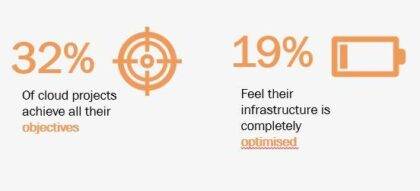Optimising Your Cloud ROI: Defining Good Goals and Standards
The path to achieving optimal cloud ROI begins with establishing well-defined goals and standards right from the inception of your cloud project.
In the first of a series of articles on how to optimise your cloud ROI, Jonathan Bailey discusses why the best place to start with cloud optimisation is at the beginning – by setting good goals and standards from the get-go.
Watch our webinar “Five Ways to Optimise Your Cloud ROI”
In an era where businesses are rapidly embracing the cloud to enhance their operations, a significant challenge has surfaced: achieving the desired ROI from cloud infrastructure projects. The insights gathered from Ekco’s 2023 Infrastructure Modernisation Survey in the UK and Ireland highlight the pressing concern that many organisations do not fully realise their cloud expectations.
According to our research, just 32% of IT leaders believe that their cloud modernisation projects had achieved their objectives, and only 19% attested that their cloud infrastructure was fully optimised, signalling a need for a fresh perspective on cloud adoption strategies.

Read the full Ekco Infrastructure Modernisation Survey 2023
Areas lacking optimisation
The path to achieving optimal cloud ROI begins with establishing well-defined goals and standards right from the inception of your cloud project. The crucial starting point is determining the primary purpose of your cloud journey. Are you mainly focusing on cost savings, seeking to revolutionise your infrastructure to unlock new value, or striving to achieve a combination of these objectives?
Ekco’s survey identified four primary areas where respondents felt their optimisation efforts were lacking:
1. Cloud Monitoring
Gaining insights into cloud events, monitoring data usage, and closely observing environment performance are essential aspects of cloud optimisation. These insights enable informed decision-making and empower you to make real-time adjustments for greater efficiency.
2. Security
The cloud landscape introduces unique security challenges. This includes managing the attack surface of the cloud, responding effectively to security incidents, and maintaining a comprehensive set of security practices that safeguard your digital assets. Here’s more information on our Cloud Security Services.
3. Speed
Properly sizing resources and selecting the appropriate products according to your workload requirements is critical for optimising cloud performance. This involves a thorough understanding of your data ingestion, transformation, and transfer needs to ensure peak efficiency.
4. Shadow IT Risk
Unchecked shadow IT can introduce security vulnerabilities and disrupt optimisation efforts. By mitigating the risk of unauthorised cloud resource creation and usage through robust policies, standards, and access controls, you can maintain control and security over your cloud environment.
Learn more about our cloud services
Guidelines for cloud optimisation
Ekco’s proactive approach to cloud optimisation involves a series of practical guidelines that can guide your project through each stage.

1. Operational Data
Begin with a comprehensive understanding of your existing environment. This involves monitoring, establishing baselines for performance and services, and benchmarking what qualifies as good service quality. By analysing data like transaction frequency and usage patterns, you can lay the foundation for transforming your current setup into an optimised cloud blueprint.
2. Security Optimisation
The cornerstone of security optimisation is adopting a well-defined security policy or framework. This can range from an internal security policy that leverages established frameworks to subscribing to reputable standards such as CIS or ISO. These frameworks provide valuable guidance on managing projects and creating secure cloud environments. Additionally, the right choice of cloud products and services aligns security considerations from the outset.
3. Service Decisions
Optimise security and performance by selecting the right stock keeping unit (SKU) and cloud services for your solutions. A well-informed decision hinges on the quality of your operational data. If your benchmarks are clear, your service selections will naturally align with your goals.
4. Mitigating Shadow IT
Leverage strong monitoring practices to curtail shadow IT risks. Similar to knowing when a physical object is added to an office space, robust monitoring informs you when new cloud resources are created. Combining this with robust security measures, such as access controls and policies, can significantly reduce the likelihood of unauthorised resource usage.
Be proactive about optimisation
In conclusion, there is a definite need to redefine cloud adoption strategies. Instead of waiting until the end of a project to assess optimisation efforts, it’s key to define goals and standards early on. By establishing operational data baselines, security frameworks, and resource selection strategies, businesses can transition to the cloud with confidence, knowing that optimisation is an integral part of the journey. Cloud ROI optimisation should not be an afterthought—it’s a mindset that shapes cloud adoption from the outset.
Looking to migrate? Need to optimise? We’re cloud specialists. Get in touch today.

Question?
Our specialists have the answer
